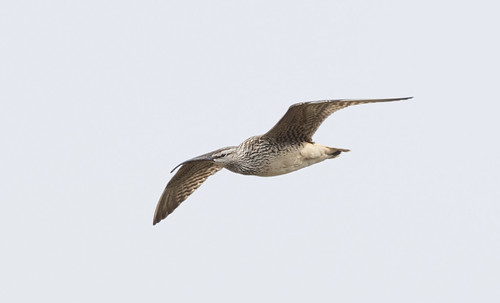For decades I've yearned to do some serious birding in Alaska for a bazillion reasons, but one of the biggest was to see a Bristle-thighed Curlew, in large part inspired by its name. I couldn't imagine why any bird would have elongated feather shafts, called bristles, on its thighs, and scientists haven't figured out why, either—I love birds of mystery. And the scientific name, Numenius tahitiensis, is equally tantalizing. The latinized Numenius, the genus which contains curlews and whimbrels, comes from Greek for "new moon," because the birds' decurved bill resembles a new crescent moon. Tahitiensis comes from Tahiti, the place where the Bristle-thighed Curlew was first collected and described for the scientific literature by Sir Joseph Banks, the naturalist accompanying Captain James Cook on his 1768-1771 voyage around the world.
 |
| Sir Joseph Banks may have been the first scientist to collect and describe a Bristle-thighed Curlew, but Native peoples in Oceana and Alaska were actually the first people to "discover" this species. |
The Bristle-thighed Curlew winters in tropical Oceana, including Micronesia, Fiji, Tuvalu, Tonga, the Hawaiian Islands, Samoa, and French Polynesia. When my family visited Hawaii in 2000, I didn’t see one, but at that time, it was considered a rare winter resident on the main Hawaiian Islands. Two decades later, it can be found reliably in winter on the northern tip of Oahu at James Campbell National Wildlife Refuge and the adjacent Kahuku Golf Course. In most if not all years, a few non-breeding subadults remain during the nesting season, so in many years at least some individuals can be found in Hawaii all year long.
For two centuries after the Bristle-thighed Curlew was first described, ornithologists had no idea where it nested. The first edition of the AOU Checklist in 1886 did list it on the strength of two specimens collected in Alaska, in May 1869 and May 1880. The specimens were identified correctly but the collectors thought those individuals must be vagrants—subadults remaining through summer on the wintering range led scientists to believe the species spent its entire life in Oceana, though no one had ever found a nest there. Spencer Baird, the first curator at the Smithsonian, knew only of the older specimen when he wrote in his 1884 book, The Water Birds of North America, that the occurrence of the specimen “in a locality so remote and so unlike its natural haunt, can only be regarded as being something purely accidental.”
David Allen and Henry Kyllingstad collected a nest and eggs north of the lower Yukon River in 1948, making the Bristle-thighed Curlew one of the last North American birds to have its nest and eggs described for ornithology. Now we know that this species' breeding range is restricted to small areas in the Seward Peninsula and the lower Yukon River, far from any settlements.
 |
| From Birds of the World, the best single resource for bird information I know of. |
Other shorebirds winter on oceanic islands, but the Bristle-thighed Curlew is the only shorebird in the world that winters exclusively on atolls and oceanic islands. During the autumn molt after arriving on these islands, Bristle-thighed Curlews undergo a flightless period, also unique among shorebirds.
On wintering islands where Bristle-thighed Curlews eat eggs, they have been observed dropping or tossing pieces of coral on them to break the shells. This tool use is again unique among shorebirds (as far as we know, anyway).
It was drummed into my head in elementary school that we should never ever modify the word unique—something is or isn’t unique, so nothing can be more unique than anything else. But I think it’s fair to say that the Bristle-thighed Curlew uniquely has more unique features than other birds.
Along with the Bar-tailed Godwit (which we also saw on the Nome part of this trip), the Bristle-thighed Curlew makes one of the longest nonstop flights known for any bird. (Arctic Terns have a longer migration, but they can mosey along, eating and resting during the journey.) All Bristle-thighed Curlews fly at least 2,500 miles nonstop each way between Alaska and the northern end of the winter range in the northwestern Hawaiian Islands. Those that winter beyond Hawaii don 't take a break as they pass near or over those islands—those birds may travel more than 3,700 miles each way, and again, they do this without stopping to rest or feed. To accomplish this, they put on huge fat deposits to fuel the flight over open ocean, and they allow their stomach, liver, and other digestive organs to atrophy. They won't be using them anyway, and this reduces the load their wings must carry.
How could I not be fascinated with such a unique bird, and how could I not want to see one in its extremely remote nesting range? Our tour set the Bristle-thighed Curlew as a target bird for the Nome leg of our adventure. Finding it can involve hours and hours of searching on the tundra, walking, and falling, on tundra tussocks. Friends who had done it told me how arduous the search is, so I spent months before we left exercising to get into shape for the long, grueling hike, or at least as in shape as a 70-year-old woman can be. Tomorrow I’ll tell you how that worked out.
(Spoiler alert: I'm the one who took all the Bristle-thighed Curlew photos shown in this blog post.)



